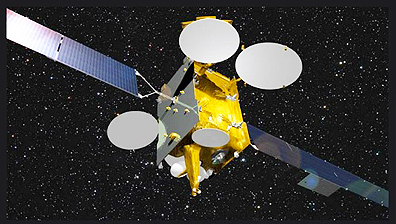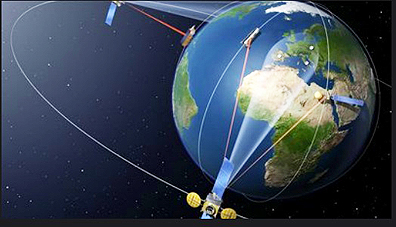 [SatNews] The Company has been selected to build the next Eutelsat satellite, and they will also be working with the ESA on the EDRS...
[SatNews] The Company has been selected to build the next Eutelsat satellite, and they will also be working with the ESA on the EDRS...
Astrium has been selected by Eutelsat Communications (Euronext Paris: ELT) to build EUTELSAT 9B, a high-power broadcast satellite addressing high-growth video markets in Europe, to be launched at the end of 2014 and located at Eutelsat’s 9 degrees East video neighborhood. Over its 15-year mission lifetime, EUTELSAT 9B will operate as many as 66 Ku-band transponders connected to a broad European widebeam and four regional beams over European countries. It will increase Eutelsat’s capacity for video services in Europe, providing wide coverage for channels seeking maximum reach into satellite homes and terrestrial headends, as well as regional footprints addressing linguistic markets for digital TV in Italy, Germany, Greece and the Nordic/Baltic regions. In addition to its broadcast mission, EUTELSAT 9B will host the first data relay payload for the European Data Relay Satellite System (EDRS) being implemented through a Public-Private Partnership (PPP) between Astrium and ESA. The EDRS system of telecommunication satellites in geostationary orbit will enable very high data rate, bi-directional data relay communications between Low Earth Orbit Earth observation satellites and an associated ground segment. Based on Astrium’s successful Eurostar E3000 platform, EUTELSAT 9B will have a launch mass of 5,300 kg and an electrical power of 12 kW. EUTELSAT 9B is the 21st satellite ordered by Eutelsat from Astrium.
 And speaking of EDRS, Astrium will partner with the European Space Agency (ESA) to design, deliver and operate the European Data Relay System (EDRS). The EDRS will be implemented through a Public-Private Partnership (PPP) between ESA and Astrium. Under the terms of the agreement the partners will jointly finance the EDRS. The ESA contract with Astrium amounts to 275 million euros. The EDRS’s two telecommunication payloads in geostationary orbit will enable broadband, bi-directional data relay between Low Earth Orbit (LEO) satellites and an associated ground segment via either of the EDRS payloads. The EDRS increases the time LEO spacecraft can be in communication with the ground and enables immediate broadband data transfer to the user. It also provides the capability to re-program LEO Earth observation (EO) satellites in almost real-time. This ensures the timely acquisition and delivery of imagery following natural disasters, and helps emergency services on the ground to accurately map the affected areas and effectively coordinate response efforts. Currently, LEO satellites can only be reprogrammed and images can only be received when the satellites pass over a specific geographic location with a dedicated ground station.
And speaking of EDRS, Astrium will partner with the European Space Agency (ESA) to design, deliver and operate the European Data Relay System (EDRS). The EDRS will be implemented through a Public-Private Partnership (PPP) between ESA and Astrium. Under the terms of the agreement the partners will jointly finance the EDRS. The ESA contract with Astrium amounts to 275 million euros. The EDRS’s two telecommunication payloads in geostationary orbit will enable broadband, bi-directional data relay between Low Earth Orbit (LEO) satellites and an associated ground segment via either of the EDRS payloads. The EDRS increases the time LEO spacecraft can be in communication with the ground and enables immediate broadband data transfer to the user. It also provides the capability to re-program LEO Earth observation (EO) satellites in almost real-time. This ensures the timely acquisition and delivery of imagery following natural disasters, and helps emergency services on the ground to accurately map the affected areas and effectively coordinate response efforts. Currently, LEO satellites can only be reprogrammed and images can only be received when the satellites pass over a specific geographic location with a dedicated ground station.
The new space data highway will provide Europe with independent, on demand access to EO data from LEO satellites in real-time. It solves the growing problem of ”data traffic jams in space” and enables an improved reactivity as well as a more intense and efficient use of EO satellites. EDRS operations will commence with the launch of the first EDRS mission at the end of 2014. The mission will be embarked on board a Eutelsat satellite: EUTELSAT 9B that will be manufactured by Astrium and located at 9° East. Astrium will also contract OHB-System, Germany, to build a second EDRS satellite for launch in 2015. The EDRS payloads of both satellites will be manufactured by TESAT, a 100 percent subsidiary of Astrium. The Laser Communication Terminals that transmit data between the EDRS and LEO satellites at up to 1.8 gigabits per second are developed and built by TESAT. This high-end technology has been developed under a contract from the German Aerospace Center (DLR).
The European Union (EU) with its Global Monitoring for Environment and Security (GMES) program and its Sentinel satellites is intended to be the anchor tenant for the service, with additional capacity on the system marketed by Astrium Services to third-party users.

